
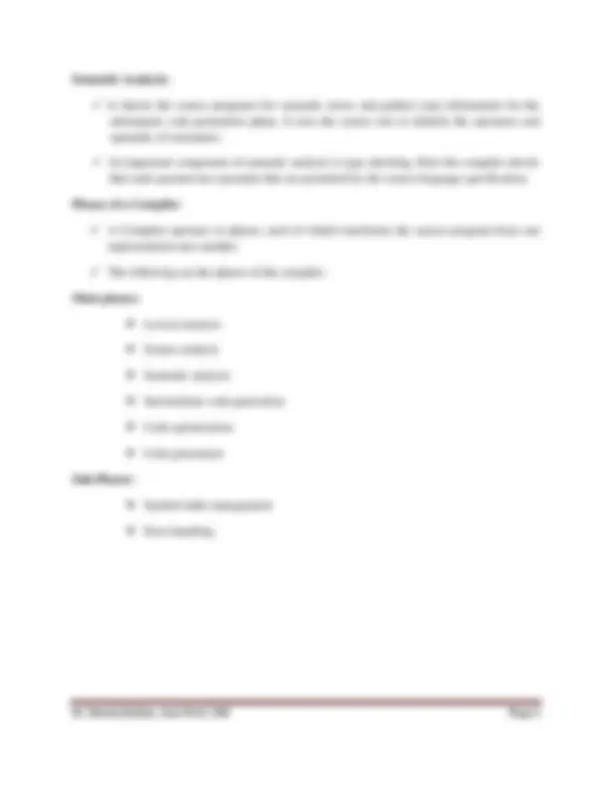
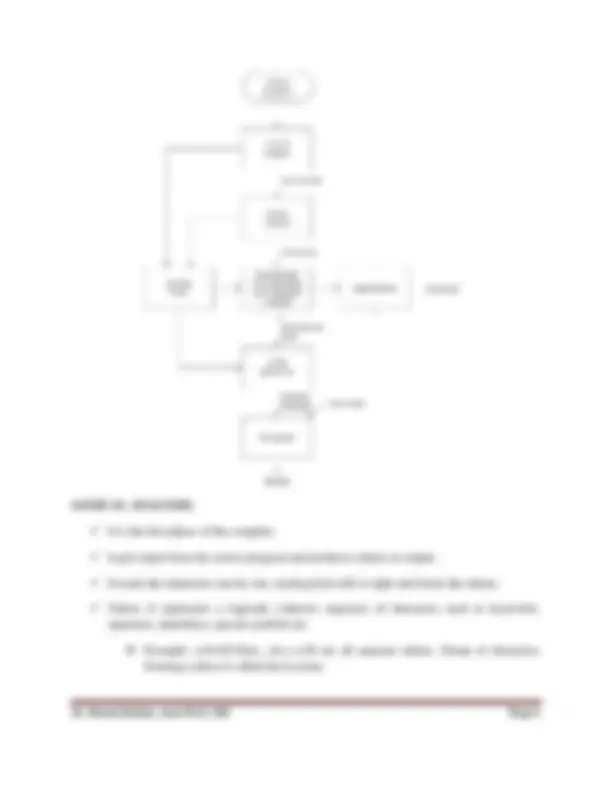
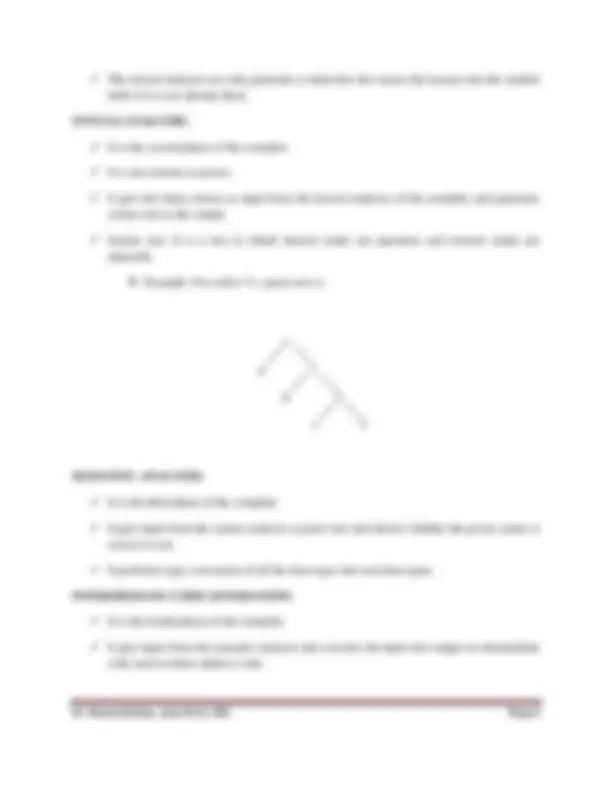
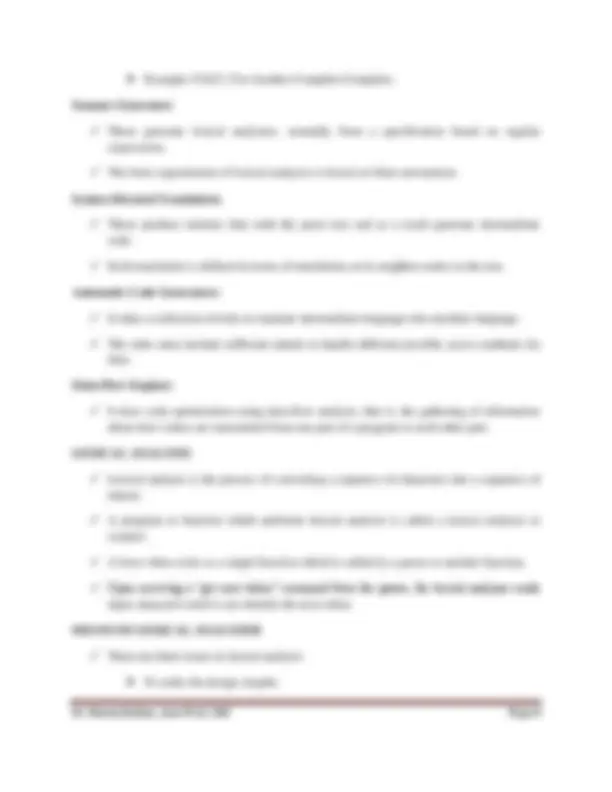
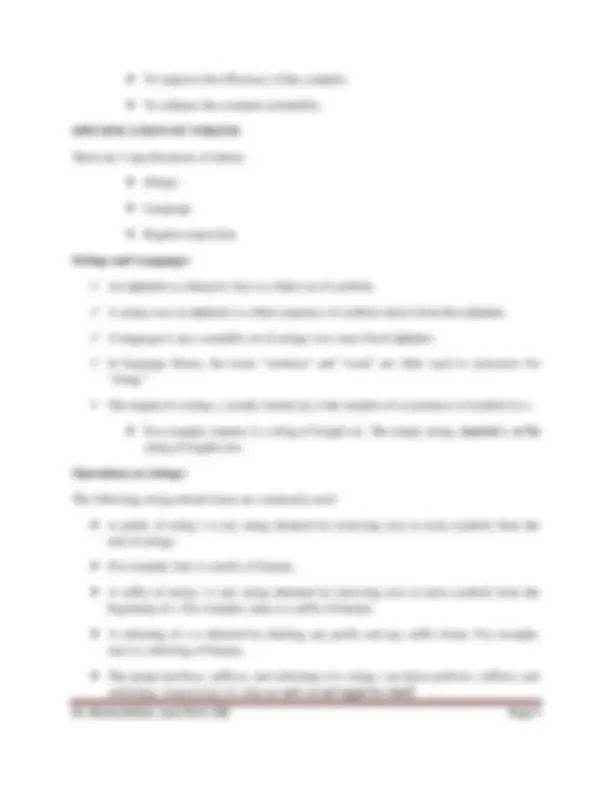
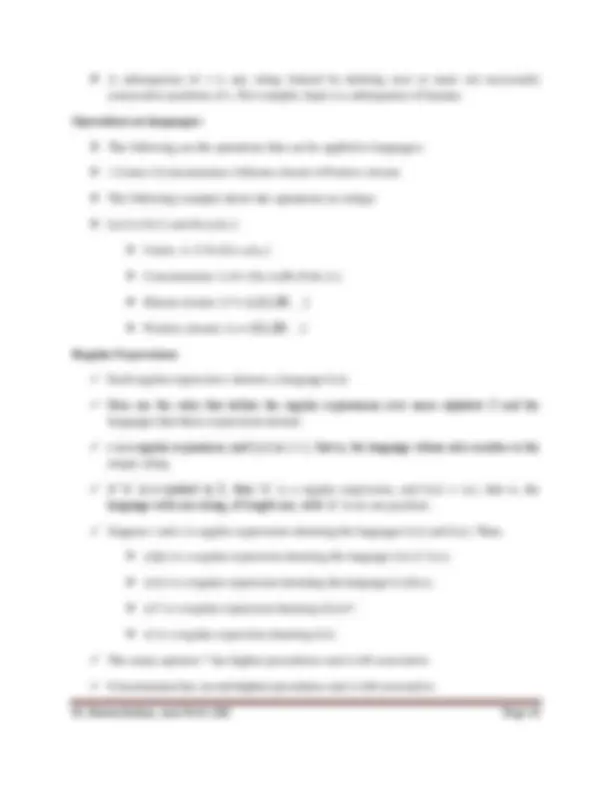


Study with the several resources on Docsity

Earn points by helping other students or get them with a premium plan


Prepare for your exams
Study with the several resources on Docsity

Earn points to download
Earn points by helping other students or get them with a premium plan
Community
Ask the community for help and clear up your study doubts
Discover the best universities in your country according to Docsity users
Free resources
Download our free guides on studying techniques, anxiety management strategies, and thesis advice from Docsity tutors
DETAILED STUDY NOTES OF UNIT 2 OF COMPILER DESIGN
Typology: Study notes
1 / 12

This page cannot be seen from the preview
Don't miss anything!







Compiler: Introduction - Analysis of the source program - phases of a compiler - Compiler construction tools-Lexical analysis - Role of the lexical analyzer - Specification of tokens – Recognition of tokens -Lexical analyzer generators- Design aspects of Lexical Analyzer
Compiler:
It is a program that translates one language (source code) to another language (target code).
It executes the whole program and then displays the errors.
Example: C, C++,COBOL, higher version of Pascal.
A compiler translates the code written in one language to some other language without changing the meaning of the program.
It is also expected that a compiler should make the target code efficient and optimized in terms of time and space.
Compiler design principles provide an in-depth view of translation and optimization process.
Compiler design covers basic translation mechanism and error detection & recovery.
It includes lexical, syntax, and semantic analysis as front end, and code generation and optimization as back-end
Analysis of the source program:
Analysis consists of 3 phases:
Linear/Lexical Analysis
Syntax Analysis
Semantic Analysis
Linear/Lexical Analysis:
It is also called scanning. It is the process of reading the characters from left to right and grouping into tokens having a collective meaning.
For example, in the assignment statement a=b+c*2, the characters would be grouped into the following tokens:
The identifier1‘a’
The assignment symbol (=)
The identifier2 ‘b’
The plus sign (+)
The identifier3 ‘c’
The multiplication sign (*)
The constant ‘2’
Syntax Analysis:
It is called parsing or hierarchical analysis. It involves grouping the tokens of the source program into grammatical phrases that are used by the compiler to synthesize output.
They are represented using a syntax tree as shown below:
A syntax tree is the tree generated as a result of syntax analysis in which the interior nodes are the operators and the exterior nodes are the operands.
This analysis shows an error when the syntax is incorrect.
It is the first phase of the compiler.
It gets input from the source program and produces tokens as output.
It reads the characters one by one, starting from left to right and forms the tokens.
Token: It represents a logically cohesive sequence of characters such as keywords, operators, identifiers, special symbols etc.
Example: a+b=20 Here, a,b,+,=,20 are all separate tokens. Group of characters forming a token is called the Lexeme.
The lexical analyzer not only generates a token but also enters the lexeme into the symbol table if it is not already there.
SYNTAX ANALYSIS:
It is the second phase of the compiler.
It is also known as parser.
It gets the token stream as input from the lexical analyzer of the compiler and generates syntax tree as the output.
Syntax tree: It is a tree in which interior nodes are operators and exterior nodes are operands.
Example: For a=b+c*2, syntax tree is
It is the third phase of the compiler.
It gets input from the syntax analysis as parse tree and checks whether the given syntax is correct or not.
It performs type conversion of all the data types into real data types.
INTERMEDIATE CODE GENERATION:
It is the fourth phase of the compiler.
It gets input from the semantic analysis and converts the input into output as intermediate code such as three-address code.
It is a data structure containing a record for each identifier, with fields for the attributes of the identifier.
It allows to find the record for each identifier quickly and to store or retrieve data from that record.
Whenever an identifier is detected in any of the phases, it is stored in the symbol table.
ERROR HANDLING:
Each phase can encounter errors.
After detecting an error, a phase must handle the error so that compilation can proceed.
In lexical analysis, errors occur in separation of tokens.
In syntax analysis, errors occur during construction of syntax tree.
In semantic analysis, errors occur when the compiler detects constructs with right syntactic structure but no meaning and during type conversion.
In code optimization, errors occur when the result is affected by the optimization.
In code generation, it shows error when code is missing etc.
COMPILER CONSTRUCTION TOOLS:
These are specialized tools that have been developed for helping implement various phases of a compiler.
The following are the compiler construction tools:
Parser Generators
Scanner Generator
Syntax-Directed Translation
Automatic Code Generators
Data-Flow Engines
Parser Generators:
These produce syntax analyzers, normally from input that is based on a context-free grammar. -It consumes a large fraction of the running time of a compiler.
Example-YACC (Yet Another Compiler-Compiler).
Scanner Generator:
These generate lexical analyzers, normally from a specification based on regular expressions.
The basic organization of lexical analyzers is based on finite automation.
Syntax-Directed Translation:
These produce routines that walk the parse tree and as a result generate intermediate code.
Each translation is defined in terms of translations at its neighbor nodes in the tree.
Automatic Code Generators:
It takes a collection of rules to translate intermediate language into machine language.
The rules must include sufficient details to handle different possible access methods for data.
Data-Flow Engines:
It does code optimization using data-flow analysis, that is, the gathering of information about how values are transmitted from one part of a program to each other part.
LEXICAL ANALYSIS
Lexical analysis is the process of converting a sequence of characters into a sequence of tokens.
A program or function which performs lexical analysis is called a lexical analyzer or scanner.
A lexer often exists as a single function which is called by a parser or another function.
Upon receiving a “get next token” command from the parser, the lexical analyzer reads input characters until it can identify the next token.
ISSUES OF LEXICAL ANALYZER
There are three issues in lexical analysis:
To make the design simpler.
A subsequence of s is any string formed by deleting zero or more not necessarily consecutive positions of s. For example, baan is a subsequence of banana.
Operations on languages:
The following are the operations that can be applied to languages:
1.Union 2.Concatenation 3.Kleene closure 4.Positive closure
The following example shows the operations on strings:
Let L={0,1} and S={a,b,c}
Union : L U S={0,1,a,b,c}
Concatenation: L.S= {0a,1a,0b,1b,0c,1c}
Kleene closure: L*= {ε,0,1,00….}
Positive closure: L+= {0,1,00….}
Regular Expressions
Each regular expression r denotes a language L(r).
Here are the rules that define the regular expressions over some alphabet Σ and the languages that those expressions denote:
ε is a regular expression, and L(ε) is { ε }, that is, the language whose sole member is the empty string.
If ‘a’ is a symbol in Σ, then ‘a’ is a regular expression, and L(a) = {a}, that is, the language with one string, of length one, with ‘a’ in its one position.
Suppose r and s is regular expressions denoting the languages L(r) and L(s). Then,
(r)|(s) is a regular expression denoting the language L(r) U L(s).
(r)(s) is a regular expression denoting the language L(r)L(s).
(r)* is a regular expression denoting (L(r))*.
(r) is a regular expression denoting L(r).
The unary operator * has highest precedence and is left associative.
Concatenation has second highest precedence and is left associative.
It has lowest precedence and is left associative.
RECOGNITION OF TOKENS
Consider the following grammar fragment:
stmt→if expr then stmt
|if expr then stmt else stmt
|ε
expr→term relop term
|term
term→id
|num
where the terminals if , then, else, relop, id and num generate sets of strings given by the following regular definitions:
if → if
then → then
else → else
relop → <|<=|=|<>|>|>=
id → letter(letter|digit)*
num → digit+ (.digit+)?(E(+|-)?digit+)?
For this language fragment the lexical analyzer will recognize the keywords if, then, else, as well as the lexemes denoted by relop, id, and num.
To simplify matters, we assume keywords are reserved; that is, they cannot be used as identifiers.
Lexical analyzer generators:
There is a wide range of tools for constructing lexical analyzers.
Lex